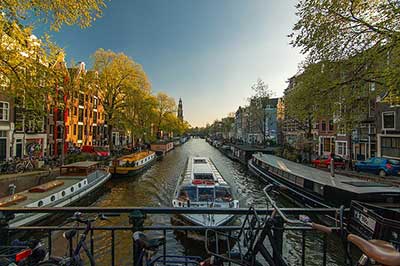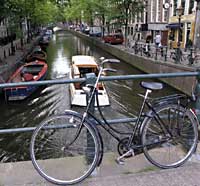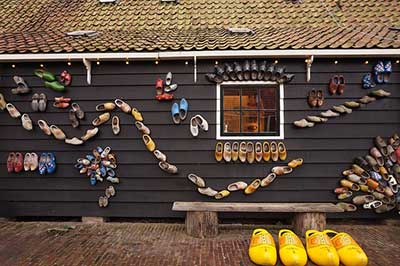Your Discovery Guide to Amsterdam
Amsterdam is the capital city of the Netherlands, also known as Holland. It lies on the banks of two rivers, the Amstel and IJ, and from its canals to the world famous museums and historical sights, Amsterdam has long been considered as one of the most romantic and wonderful cities in the whole continent of Europe. It covers an area of about 207 square kilometers and is populated by around 1,730,000 inhabitants. Today, it is known as the “Venice of the North” as it is built on 90 islands connected by 400 stone bridges across 100 kilometers of the canals.
 Established in the later 12th century as a small fishing village on the banks of the Amstel River, Amsterdam has one of the largest historic city centers in Europe. Amsterdam historically has been a major trading post during the colonial times, the reason why you will find scattered town houses around the otherwise neatly aligned canals. These were made by the then wealthy tradesmen.
Established in the later 12th century as a small fishing village on the banks of the Amstel River, Amsterdam has one of the largest historic city centers in Europe. Amsterdam historically has been a major trading post during the colonial times, the reason why you will find scattered town houses around the otherwise neatly aligned canals. These were made by the then wealthy tradesmen.
One of the focal points of interest in this city is the Golden Age of Netherlands that dates largely from the 17th century. It was noted that at this time, a row of concentric, semi-circular canals were built around the older city center, but this establishment still defines the city’s layout and appearance today. Amsterdam now has fine houses and mansions that are situated along the canals. Most of these houses and mansions are lived in, while others are now offices and public buildings.
There is nothing quite like this small capital and its deep cultural heritage. Not only is Amsterdam colorful, serene, and romantic, it is also exciting and sophisticated. Amsterdam is a major port conveniently located near Schiphol Airport and is the site of many national and international business conferences. It is also at the heart of the ever expanding European Union.
Amsterdam has one of the finest and most reliable transportation networks in the whole continent of Europe. It is this fact that makes Amsterdam a popular location for industry. As you might notice in the city, fast and frequent trains and buses run throughout the country and are an excellent way to travel from the city of Amsterdam to other parts of the country. What’s more, both bus and rail in Amsterdam provide effective connections to Central Station and the Schiphol International Airport.
Amsterdam is a compact and instantly likeable city, very appealing to look at and pleasing to walk around. It is a city where the parochial and international behaviors meet, and it is where you will feel a welcoming attitude towards visitors.
Getting Around Amsterdam
The layout of the city of Amsterdam is generally determined by a web of canals radiating out from a historical core to loop right round the center. These planned seventeenth century extensions to the medieval town make for a distinctly elegant urban environment. This is further shown by the presence of tall gabled houses that are reflected in the black green waters of the city.
On Foot: The central part of Amsterdam is just easy to get around. Most of what is there to see, apart from the Red Light District and Dam Square, is a short tram or bike ride away.
 By Bike: A great way to see the sights of Amsterdam is to travel by bike. Today, there are more than 500,000 bikes in the city. As such, you can hire one of them for about €7 per day. Perhaps the most important thing to consider is to lock your bike, as bike theft is a huge problem in Amsterdam.
By Bike: A great way to see the sights of Amsterdam is to travel by bike. Today, there are more than 500,000 bikes in the city. As such, you can hire one of them for about €7 per day. Perhaps the most important thing to consider is to lock your bike, as bike theft is a huge problem in Amsterdam.
By Bus/Metro: Both the tram and metro are useful if you are traveling to the outskirts of Amsterdam, but otherwise you probably won’t need to use them. There are two metro stations, at the Nieuwmarkt and Waterlooplein.
By Tram: Finally, you can get around Amsterdam by tram, the most important mode of public transport in the Dutch capital. There are 15 different lines and they are the backbone of the city’s public transport network. Just note that the best tram for your Amsterdam sightseeing is No.20, which stops close to most of the tourist attractions.
Things to See in Amsterdam
During the 60’s and 70’s, Amsterdam was known to be a haven for hippies. It has moved on since then to be a bigger economy and a successful cosmopolitan business centre. Today, Amsterdam is the 5th busiest tourist destination in Europe with more than 4.2 million international visitors, with the number of visitors growing rapidly and steadily over the past decade.
The culture of free thinking and collective living has not totally gone away. Only the free culture is not an offshoot of semi legal toxic and exotic plants, but a by product of successful economic growth. It’s not that one can’t smoke hash but Amsterdam has slowly transformed itself into a city where you can smoke hash and enjoy the city without a big damage to the pocket.
When you think about Amsterdam, it is very hard not to imagine misty cafes and scantily clothed women moving provocatively in windows with red lights. Many travelers return to this ultimate city of “sin” because of these sights alone.
Amsterdam is not just about sex and drugs, however. The Netherlands has the greatest number of great museums per square foot than anywhere else in the world, all serving as the home to the world’s richest and most comprehensive collection of art masterpieces, dating back from the 15th century up to the 20th century.
Aside from arts, Amsterdam, Holland is famous for its excellent performance halls that play host to music, dance and the widely acclaimed performing arts festivals. If you take a tram ride 10 minutes from the heart of the city, you can overwhelm yourself with those narrow streets occupied with nothing else other than the cyclist and a car every now and then. The city has much to offer for sightseeing and restaurants.
The City Government
Amsterdam, as all Dutch municipalities, is governed by a mayor, his wethouders (aldermen), and the municipal council. Nevertheless, the city is subdivided into fifteen stadsdelen (boroughs), which is a system implemented in the 1980s to improve local governance. The establishment of this system is what sets Amsterdam unique from other Dutch municipalities. The stadsdelen are said to be responsible for a number of activities that previously had been governed and managed by the central city. Fourteen of these have their respective council, which is chosen by a popular election. Westerpoort, the fifteenth, covers the harbour of the city and has very few inhabitants. It is also governed by the central municipal council.
The Language
 When it comes to language, many of the people in Amsterdam are proud of the fact that just about everyone speaks English fluently. Although many also speak German and French, it is worth noting that in this capital city of Netherlands, it is a tradition that if you are English speaking, then speak English, unless you speak Dutch too because you are more likely to offend than do anyone a favor by trying out your French or German.
When it comes to language, many of the people in Amsterdam are proud of the fact that just about everyone speaks English fluently. Although many also speak German and French, it is worth noting that in this capital city of Netherlands, it is a tradition that if you are English speaking, then speak English, unless you speak Dutch too because you are more likely to offend than do anyone a favor by trying out your French or German.
There is a common misconception in the language of Amsterdam; one of those is that Dutch is very close to German. The truth is, they are not mutually intelligible: Dutch people have to learn German at school, and in general they speak better English than German. However, Dutch and German are similar in the same sort of way that French and Italian are similar.
The Weather
There is actually of good weather any time of the year in Amsterdam. The typical weather ranges from a little around freezing in the depths of winter to typically pleasant sunny days of 20 to 25 degrees Celsius in the summer. There is also a little snow during the winter season. Furthermore, the spring and autumn are pleasant in Amsterdam; however these seasons can be wet, with 100+ mm of rain per month. It is just so normal in this area that you will find people or even you yourself often carrying an umbrella even on the hottest of July days, as summer rain in the morning sometimes precedes the arrival of bright sunshine later.
Safety and Health
Amsterdam is a safe city, thus there is nothing really to fear from walking in any part of the city. It has been noted that even in the red-light district around the Oude Kerk, tourists are always spotted wandering around. However, as in any large cities in other parts of the world, you should beware of pick pockets. And, don’t try to photograph the women in the red-light district for that would be risky. In terms of water, the water from taps is perfectly drinkable.
Traveling to Amsterdam
By Air: Flights to the city usually arrive in the Schiphol Airport, which is approximately 18 kilometers away, southwest of the city center. From the Schiphol airport, trains typically leave for Central Station every 20 minutes and so the journey takes 20 minutes. Then, from the Central Station, you’ll get to have a taxi ride to town which takes approximately 15 minutes and the journey will cost you approximately €30.
By Train: You can also travel to Amsterdam by train as there are domestic and international trains that go to Amsterdam. They typically arrive in the Central Station, which is located in the heart Amsterdam’s city center.
By Bus: The buses arriving and leaving Amsterdam do so from Amstel Station. This station is linked to Central Station by metro. Buses leaving for London, Brussels, and Amsterdam’s other cities also depart from the Amstel Station.
